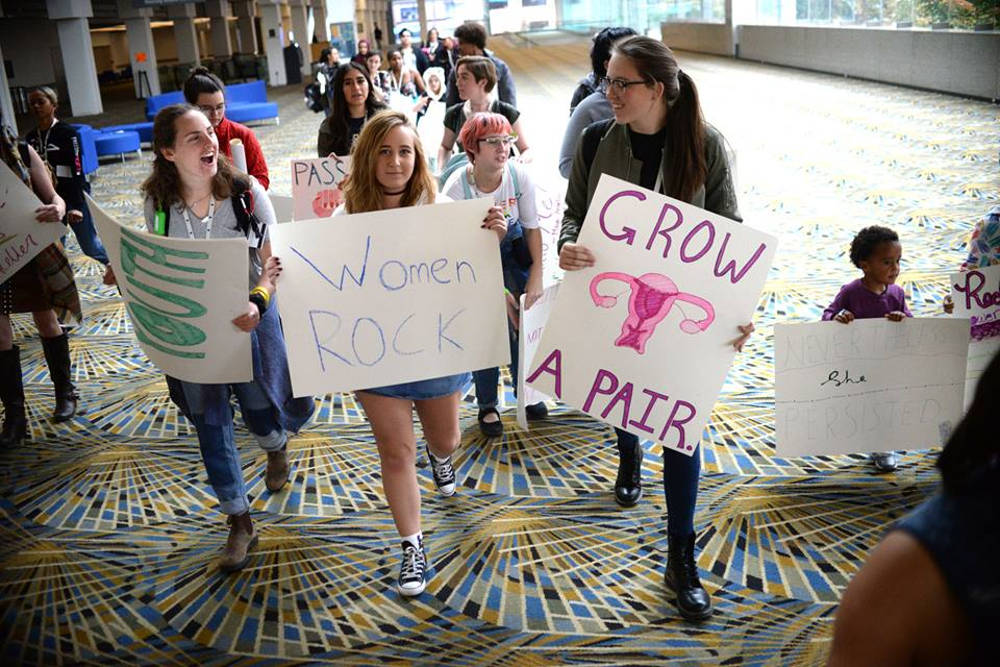WASHINGTON (ViaNews) – Women’s rights has been a topic of debate in America for centuries and this has not changed in the current year 2017. Donald Trump ran his election on the support of the conservative right who generally take a strict view on women’s rights issues such as birth control and abortion. During his time in office, both birth control and abortion have been under scrutiny. What some would call a continuous attack on women’s control over their bodies has provided a more visible opponent for feminists.
According to Dani Bisignani, a former instructor at Purdue University and former blogger at The Gender Press, in the first wave of feminism most women would not have identified as feminists.
“The term “feminist” wasn’t coined until the late 1800s, in France (feminisme). The word wasn’t introduced to the U.S. until the early 1900s and was not used popularly until the beginning of the U.S. women’s movement in the 1960s, or the beginning of the second wave. Early feminists were more likely to identify themselves as suffragists.”
Suffragettes were women in the late 19th and early 20th century who advocated for women’s right to vote—the main platform the first wave of feminism was built on. Unlike feminism in the sixties, this movement fought mainly against legal issues.
In 1848, when the first wave began in conjunction with the Seneca Falls Convention, not only were women not allowed to vote, they lived under many legal restrictions.
Bisignani named a few of these restrictions on The Gender Press:
“To put the time period in perspective, consider that at the time of first wave feminism, women were legally prevented from:
- owning property
- executing wills or signing legal documents
- serving on juries (even if the defendant was a woman)
- voting in elections (or even local meetings)
- refusing to have sex with their husbands
- attending university (or depending on race, class, and region, attending school at all)
- having legal custody of their children (both wives and children were legally owned by husbands)
- divorcing their husbands”
The women of the first movement were more concerned with these legal restrictions they lived under and less concerned with social issues.
“Think of first wave feminism not as the beginning of women fighting for equality, but as the beginnings of an organized, nation-wide movement advocating women’s rights in the western world, including the United Kingdom, Canada, and the U.S,” said Bisignani.
In her essay, Four Waves of Feminism, Professor Martha Rampton of Pacific University Oregon said, “The first wave of feminism took place in the late nineteenth and early twentieth centuries, emerging out of an environment of urban industrialism and liberal, socialist politics. The goal of this wave was to open up opportunities for women, with a focus on suffrage.”
In her essay, Rampton goes on to describe how the first wave was primarily powered by white, cisgender, middle-class women, despite suffragists working alongside abolitionists. This exclusive and primarily legal platform first wavers built set the foundation for the Second Wave of Feminism which pushed beyond legal matters and into the social sphere.
“This wave [the Second Wave of Feminism] unfolded in the context of the anti-war and civil rights movements and the growing self-consciousness of a variety of minority groups around the world,” said Rampton. “The New Left was on the rise, and the voice of the second wave was increasingly radical. In this phase, sexuality and reproductive rights were dominant issues, and much of the movement’s energy was focused on passing the Equal Rights Amendment to the Constitution guaranteeing social equality regardless of sex.”
Bisignani said, “Second wave feminism was a reaction to this post-war obsession with the ideal of the contented housewife and suburban domesticity, a lifestyle that often isolated women and severely limited their choices and opportunities.”
Unlike the women before them, women involved in the Second Wave of Feminism proudly called themselves feminists.
Feminists, for the most part, were collected and “radical” in their fight for social equality. They were ambitious and had no issue taking their protests to the street, most notably the protests against the Miss America pageant in 1968 and 1969 where protestors crowned a sheep as Miss America.
However, one aspect of the second wave that was most significant was the paradox of inclusivity and exclusivity. Women from marginalized communities, including women of color and, to a certain extent, trans-women and lesbians, were welcomed and played a key role in social change during the time. Yet, while welcoming women beyond the white, cisgender, middle class, this wave did not acknowledge the unique struggle of these marginalized women and rode on the wave of universal sisterhood. Men, in many cases, were almost excluded entirely.
Rampton said, “Whereas the first wave of feminism was generally propelled by the middle class, Western, cisgender, white women, the second phase drew in women of color and developing nations, seeking sisterhood and solidarity, claiming ‘Women’s struggle is class struggle.’ Feminists spoke of women as a social class and coined phrases such as ‘the personal is political’ and ‘identity politics’ in an effort to demonstrate that race, class, and gender oppression are all related… One of the strains of this complex and diverse ‘wave’ was the development of women-only spaces and the notion that women working together create a special dynamic that is not possible in mixed-groups, which would ultimately work for the betterment of the entire planet.”
Since the second wave, progress has continued but always with disgruntlement from women of the previous generation. Similar to how first wavers did not fully understand the “extremism” of their descendants, feminists from the second wave were confused when their daughters refused the term feminist, opted to wear high heels, and, generally, did not see femininity (typical attributes and actions associated with women) as separate from being strong, capable and independent.
“An aspect of third-wave feminism that mystified the mothers of the earlier feminist movement was the readoption by young feminists of the very lip-stick, high-heels, and cleavage proudly exposed by low cut necklines that the first two phases of the movement identified with male oppression. Pinkfloor expressed this new position when she said that it’s possible to have a push-up bra and a brain at the same time,” said Rampton.
Now, in the Fourth Wave of Feminism, several aspects of the second and third waves are being combined. These include inclusivity but not solely in name, in action, as well. The struggles of women from marginalized communities are recognized as unique from those of the white, cisgender female. Many men identify as feminist and are welcomed in the movement as allies.

The movement has also become digital. Makeup, fashion, and beauty are not looked down on by fourth wave feminists. Instead, they are seen as the individual choice of a woman and the ability to choose is primarily what this wave is built on.
“The emerging fourth wavers are not just reincarnations of their second wave grandmothers; they bring to the discussion important perspectives taught by third wave feminism. They speak in terms of intersectionality whereby women’s suppression can only fully be understood in a context of the marginalization of other groups and genders—feminism is part of a larger consciousness of oppression along with racism, ageism, classism, ableism, and sexual orientation (no “ism” to go with that),” said Rampton. “Among the third wave’s bequests is the importance of inclusion, an acceptance of the sexualized human body as non-threatening, and the role the internet can play in gender-bending and leveling hierarchies. Part of the reason a fourth wave can emerge is because these millennials’ articulation of themselves as “feminists” is their own: not a hand-me-down from grandma. The beauty of the fourth wave is that there is a place in it for all –together.
However, the fourth wave has not been without its opponents. Because we live in a time where women can vote, hold leadership positions, and idols like Beyonce and Taylor Swift claim the title, many thought feminism was no longer needed.
In 2013, writer and co-host of the NPR podcast Invisibilia, Hanna Rosin said, “In the early days of the feminist movement, every small victory was celebrated. There was exultation, liberation, a sense of joy at women’s progress that seems largely absent today. Somehow, the mood of the movement has shifted into reverse: the closer women get to real power, the more they cling to the idea that they are powerless.”
Those who thought feminism was no longer needed believed women were equal in society and, so the time for feminism had passed but with the election of Trump and the “draining of the swamp,” for some, the enemy feminists had been fighting took physical form.
In the 2017 article, Donald Trump is the best — and worst — thing that’s happened to modern American feminism, Assistant Managing Editor for Special Projects at CNN, Jodi Enda, addresses this revelation. Enda said, “His defeat of the first woman who might have been president — coupled with his incendiary comments about women and his divisive policies on reproductive rights and other issues — lit a fire under a movement that had failed to excite younger generations of women who benefited from the battles of the last century and saw no need to keep fighting. They do now. And so do their mothers and grandmothers.”
The availability of birth control and access to safe abortion had become relatively commonplace until now when the abolishment of these procedures and prescriptions is a distinct possibility. What their grandmothers may consider extremism, fourth wavers see as a necessity. What their mothers may see as a rejection of femininity, fourth wavers see as a single choice among many and like those that came before them, these feminists are standing strong.





